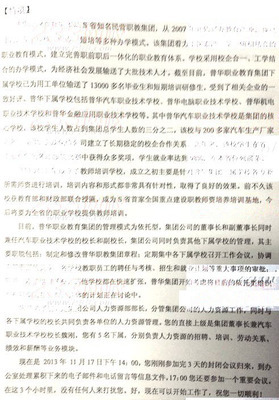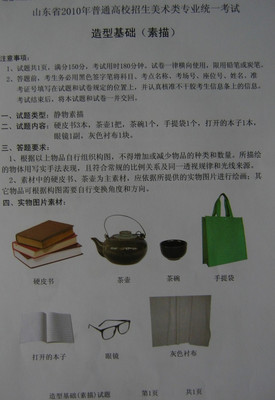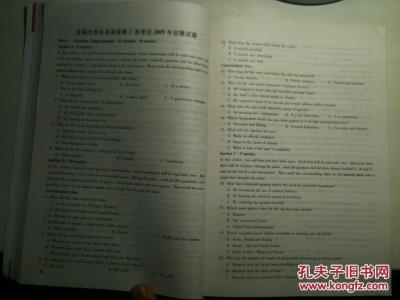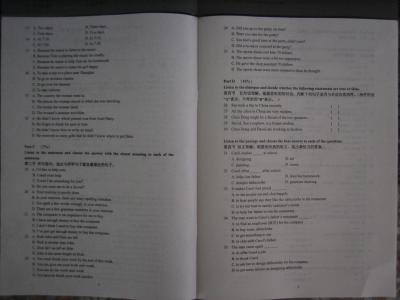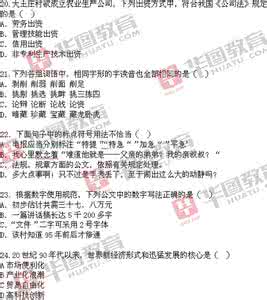2016年全国硕士研究生入学全真模拟考试
英语(二)
Section I Use of English
Directions: Read the following text. Choose the best word(s) for each numbered blank and mark A, B, C or D on the ANSWER SHEET. (10 points)
Are we at the beginning of another Age of Exploration? Perhaps even more importantly, are we at the beginning of Age of Colonization? As the population of the world increases towards the point the earth can no longer support all the people new world, Columbus did, on which human life will be possible? At this point in the space age, no one that we will not see tomorrow the kind of space travel that fiction and the movies have shown. It will be a long time before we have flights that run to human minerals that we may find on the planets Great problems must be solved we could send colonists out into space. The distances that must be and the length of time it takes to do that can hardly be really understand from radiation, for example, or from pieces of matters in space, or from contamination from forms of life that might there. There is also need for humans to take their own environment into space them. So far no "island" has been discovered in space on which people can exist without systems
that life, and these systems must accompany any future space Finally, on the most practical in space exploration.
The U.S. and Russian government have already spent billions of dollars for projects which they can receive a return only in knowledge and not in money.
1.
2. A. another A. which B. an B. when C. the C. where D. one D. whether
3.
4.
5.
6.
7.
8.
9. A. inhabited A. if A. however A. ethical B. crowded B. what B. moreover B. science C. born C. as C. otherwise C. affectional D. rushed D. such D. therefore D. action A. punctually B. permanently C. temporarily D. regularly A. get A. from B take C. gain C. on
C. before
C. ended
C. imaginary
C. from
C. survive
C. across
C. provide
C. travelers
C. point
C. concerned
C. onto D. make D. with D. until D. finished D. imaginative D. above D. live D. with D. invade D. invaders D. standard D. budgeted D. with B. in B. till B. done B. imaginable B. over B. exist B among 10. A. after 11. A. covered 12. A. imagined 13. A. out 14. A. revive 15. A. around 16. A. support 17. A. tourists 18. A. grade 19. A. involved 20. A. from
B. handle B. pilots B. level B. joined B. toward
Section II Reading Comprehension
Part A
Directions: Read the following four texts. Answer the questions below each text by choosing A, B, C or D. Mark your answers on the ANSWER SHEET. (40 points)
Text 1
We all know that the normal human daily cycle of activity is of some 7-8 hours’ sleep alternation with some
16-17 hours’ wakefulness and that, broadly speaking, the sleep normally coincides with the hours of darkness. Our present concern is with how easily and to what extent this cycle can be modified.
The question is no mere an academic one. The ease, for example, with which people can change from working in the day to working at night, is a question of growing importance in industry where automation calls for round-the-clock working of machines. It normally takes from five days to one week for a person to adapt to a reversed routine of sleep and wakefulness, sleeping during the day and working at night. Unfortunately, it is often the case in industry that shifts are changed every week; a person may work from 12 midnight to 8 a.m. one week, 8 a.m. to 4p.m. the next, and 4 p.m. to 12 midnight the third, and so on. This means that no sooner has he got used to one routine than he has to change to another, so that much of his time is spent neither working nor sleeping very efficiently.
The only real solution appears to be to hand over the night shift to a number of permanent night workers. An interesting study of the domestic life and health of nightshift workers was carried out by Brown in 1957. She found a high incidence(发生率)of disturbed sleep and other disorders among those on alternating day and night shifts, but no abnormal occurrence of these phenomena among those on permanent night work.
This latter system then appears to be the best long-term policy, but meanwhile something may be done to relieve the strains of alternate day and night work by selecting those people who can adapt most quickly to the changes of routine. One way of knowing when a person has adapted is by measuring his body temperature. People engaged in normal daytime work will have a high temperature during the hours of wakefulness and a low one at night; when they change to night work, the pattern will only gradually go back to match the new routine and the speed with which it does so parallels, broadly speaking, the adaptation of the body as a whole, particularly in terms of performance. Therefore, by taking body temperature at intervals of two hours throughout the period of wakefulness it can be seen how quickly a person can adapt to a reversed routine, and this could be used as a basis for selection. So far, however, such a form of selection does not seem to have been applied in practice.
21. Why is the question of “how easily people can get used to working at night” not a mere academic question?
A. Because few people like to reverse the cycle of sleep and wakefulness.
B. Because sleep normally coincides with the hours of darkness.
C. Because people are required to work at night in some fields of industry.
D. Because shift work in industry requires people to change their sleeping habits.
22. The main problem of the round-the-clock working system lies in_____.
A. the inconveniences brought about to the workers by the introduction of automation.
B. the disturbance of the daily life cycle of workers who have to change shifts too frequently
C. the fact that people working at night are often less effective
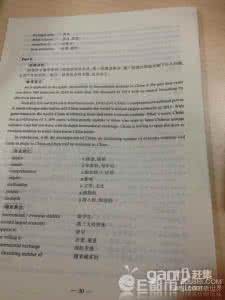
D. the fact that it is difficult to find a number of good night workers
23. The best solution for implementing the 24-hour working system seems to be_____.
A. to change shifts at longer intervals
B. to have longer shifts
C. to arrange for some people to work on night shifts only
D. to create better living conditions for night workers
24. It is possible to find out if a person has adapted to the changes of routine by measuring his body temperature because_____.
A. body temperature changes when the cycle of sleep and wakefulness alternates
B. body temperature changes when he changes to night shift or back
C. the temperature reverses when the routine is changed
D. people have higher temperatures when they are working efficiently
25. Which of the following statements is NOT TRUE?
A. Body temperature may serve as an indication of a worker’s performance.
B. The selection of a number of permanent night shift workers has proved to be the best solution to problems of the round-the-clock working system.
C. Taking body temperature at regular intervals can show how a person adapts to the changes of routine.
D. Disturbed sleep occurs less frequently among those on permanent night or day shifts.
Text 2
Clothes play a critical part in the conclusions we reach by providing clues to who people are, who they are not, and who they would like to be. They tell us a good deal about the wearer’s background, personality, status, mood, and social outlook.
Since clothes are such an important source of social information, we can use them to manipulate people’s impression of us. Our appearance assumes particular significance in the initial phases of interaction that is likely to occur. An elderly middle-class man or woman may be alienated (疏远) by a young adult who is dressed in an unconventional manner regardless of the person’s education, background, or interests.
People tend to agree on what certain types of clothes mean. Adolescent girls can easily agree on the lifestyles of girls who wear certain outfits,including the number of boyfriends they likely have had and whether they smoke or drink. Newscasters, or the announcers who read the news on TV, are considered to be more convincing, honest, and competent when they are dressed conservatively. And college students who view themselves as taking an active role in their interpersonal relationships say they are concerned about the costumes they must wear to play these roles successfully. Moreover, many of us can relate instances in which the clothing we wore changed the way we felt about ourselves and how we acted. Perhaps you have used clothing to gain confidence when you anticipated a stressful situation, such as a job interview or a court appearance.
In the workplace, men have long had well-defined precedents and role models for achieving success. It has been otherwise for women. A good many women in the business world are uncertain about the appropriate mixture of “masculine” and “feminine” attributes they should convey by their professional clothing. The variety of clothing alternatives to women has also been greater than that available for men. Male administrators tend to judge women more favorably for managerial positions when the women display less “feminine” grooming (打扮) — shorter hair, moderate use of make-up, and plain tailored clothing. As one male administrator confessed, “An attractive woman is definitely going to get a longer interview, but she won’t get a job.”
A. provides clues for people who are critical of us.
B. indicates our likes and dislikes in choosing a career.
C. has a direct influence on the way people regard us.
D. is of particular importance when we get on in age.
27. From the third paragraph of the passage, we can conclude that young adults tend to believe that certain types of clothing can
A. change people’s conservative attitudes towards their lifestyles.
B. help young people make friends with the opposite sex.
C. make them competitive in the job market.
D. help them achieve success in their interpersonal relationships.
28. The word “precedents” (Line 1, Para. 4 A. early acts for men to follow as examples.
B. particular places for men to occupy especially because of their importance.
C. things that men should agree upon.
D. men’s beliefs that everything in the world has already been decided.
A. the variety of professional clothing is too wide for them to choose.
B. women are generally thought to be only good at being fashion models.
C. men are more favorably judged for managerial positions.
D. they are not sure to what extent they should display their feminine qualities through clothing.
30. What is the passage mainly about?
A. Dressing for effect.
B. How to dress appropriately.
C. Managerial positions and clothing.
D. Dressing for the occasion.
Text 3
It is worth looking at one or two aspects of the way a mother behaves towards her baby. The usual fondling, cuddling and cleaning require little comment, but the position in which she holds the baby against her body when resting is rather revealing. Careful American studies have disclosed the fact that 80 percent of mothers cradle their infants in their left arms, holding them against the left side of their bodies. If asked to explain the significance of this preference most people reply that it is obviously the result of the predominance of right-handedness in the population. By holding the babies in their left arms, the mothers keep their dominant arm free for manipulations. But a detailed analysis shows that this is not the case. True, there is a slight difference between right-handed and left-handed females, but not enough to provide an adequate explanation. It emerges that 83 percent of right-handed mothers hold the baby on the left side, but then so do 78 percent of left-handed mothers. In other words, only 22
percent of the left-handed mothers have their dominant hands free for actions. Clearly there must be some other, less obvious explanation.
The only other clue comes from the fact that the heart is on the left side of the mother's body. Could it be that the sound of her heart-beat is the vital factor? And in what way? Thinking along these lines, it was argued that perhaps during its existence inside the body of the mother, the growing embryo (胎儿) becomes fixated ('imprinted') on the sound of the heart beat. If this is so, then the re-discovery of this familiar sound after birth might have a calming effect on the infant, especially as it has just been thrust into a strange and frighteningly new world outside. If this is so, then the mother, either instinctively or by an unconscious series of trials and errors would soon arrive at the discovery that her baby is more at peace if held on the left against her heart, than on the right.
This may sound far-fetched, but tests have now been carried out which reveal that it is nevertheless the true explanation.
A. that the holding of the babies on the left is the result of the heart-beating on the left.
B. that the holding of the babies on the left is the result of the predominance of right-handedness in the population.
C. that the holding of the babies on the left is the result of the predominance of left-handedness in the population.
D. that the holding of the babies on the left is the result of the heart-beating on the right.
A. The author thinks that we can learn nothing new from the usual fondling, cuddling and cleaning of babies by their mothers.
B. It is rather unusual for a mother to hold her baby against her body when resting.
C. Eighty percent of American mothers put their babies on the left side of the cradle.
D. The author does not agree that there is a predominance of right-handedness in the population.
A. because of the fact that the heart is on the left side of the mother's body.
B. because of the fact that the heart is on the left side of the baby's body.
C. in order to keep their left arms free for other work.
D. in order to keep their right arms free for other work.
A. strange and frighteningly new.
B. new and more at peace.
C. fixated as the sound of the heart beat
D. calm and effective.
35. The mother who holds her baby on the left
A. knows that her heart-beat has a calming effect on the baby.
B. keeps her dominant arm free for manipulations.
C. instinctively or by an unconscious series of trials and errors soon arrives at the discovery that her baby is more at peace if held on the left against her heart.
D. gives the usual fondling, cuddling and cleaning little comment.
Text 4
The study of philosophies should make our own ideas flexible. We are all of us apt to take certain general ideas for granted, and call them common sense. We should learn that other people have held quite different ideas, and that our own have started as very original guesses of philosophers.
A scientist is apt to think that all the problems of philosophy will ultimately be solved by science. I think this is true for a great many of the questions on which philosophers still argue. For example, Plato thought that when we saw something, one ray of light came to it from the sun, and another from our eyes and that seeing was something like feeling with a stick. We now know that the light comes from the sun, and is reflected into our eyes. We don’t know in much detail how the changes in our eyes give rise to sensation. But there is every reason to think that as we learn more about the physiology of the brain, we shall do so, and that the great philosophical problems about knowledge are going to be pretty fully cleared up.
But if our descendants know the answers to these questions and others that perplex us today, there will still be one field of which they do not know, namely the future. However exact our science, we cannot know it as we know the past. Philosophy may be described as argument about things of which we are ignorant. And where science gives us a hope of knowledge it is often reasonable to suspend judgment. That is one reason why Marx and Engels quite rightly wrote so little on many philosophical problems that interested their contemporaries.
But we have got to prepare for the future, and we cannot do so rationally without some philosophy. Some people say we have only got to do the duties revealed in the past and laid down by religion, and god will look after the future. Others say that the world is a machine and the course of future events is certain, whatever efforts we
may make. Marxists say that the future depends on ourselves, even though we are part of the historical process. This philosophical view certainly does inspire people to very great achievements. Whether it is true or not, it is powerful guide to action.
We need a philosophy, then, to help us to tackle the future. Agnosticism easily becomes an excuse for laziness and conservatism. Whether we adopt Marxism or any other philosophy, we cannot understand it without knowing something of how it developed. That is why a knowledge of the history of philosophy is important to Marxists, even during the present critical days.
36. What is the main idea of this text?
A. The argument whether philosophy will ultimately be solved by science or not.
B. The importance of learning philosophies, especially the history of philosophy.
C. The difference between philosophy and science.
D. A discuss about how to set a proper attitude towards future.
37. The example of what Plato thought in the passage shows that
A. science development can solve many problems for philosophers.
B. Plato knew nothing about Physics at his time.
C. the scientists have achieved a lot in terms of light theory.
D. different people have different ways of perception.
38. What field can not our descendants know?
A. The origin of human beings
B. Some questions that perplex us today.
C. Many philosophical problems which Marx and Engels wrote rather little.
D. The future.
39. How many kinds of ideas are there about the future?
A. Two B. Three C. Four D. Five
40. What are the functions of studying philosophies mentioned in the passage?
A. It would make our own idea flexible.
B. It would help prepare us for the future and guide our actions.
C. It would enable us to understand how things develop as to better tackle the future.
D. All of the above.
Part B
Directions:
Read the following text and answer the questions by choosing the most suitable subtitle from the list A-G for each numbered paragraph (41-45). There are two extra subtitles which you do not need to use. Mark your answers on the ANSWER SHEET.
A. Time sometimes stops
B. Moving in slow motion
C. We’re tricked by tech
D. Speeding up with age
E. Time doesn't fly
F. Time follows mood
G. Lost in music
Ever felt like time stands still while you're waiting for something, or that as you get older, the years slip through your fingertips with much more ease? With swaths of tech around us and virtually everything being available on demand, it's a very real possibility that our body clocks and perception of time have changed. 41. As an old saying goes, "Time flies when we're having fun." In reality, though, we know fully well that it does not. Nevertheless, psychologist James Kellaris conducted his own experiment to find out whether there’s any truth to the saying. He had people listen to a piece of music they liked, and when he later asked them how much time they thought had passed, the listeners' estimates were usually longer. Kellaris suggested that when we're enjoying ourselves, we pay more attention to the event and our minds perceive that as extra time.
42. A recent study has suggested that technology, too, is capable of altering our perception of time. Researchers found that 60% of 18-30 year-olds check their smartphones compulsively for updates, with each glance taking with it bits and pieces of the day. Having so much information readily available at out fingertips speeds up our internal clock. Likewise, each time we check Facebook or log into Twitter, we subconsciously note the time, making us more aware of how much of it has our day-to-day habits.
43. It' s commonly said that as we get older, time passes in the "blink of an eye". When young and fresh-faced, we're constantly discovering new and exciting things that we've not experienced before, and we naturally pay a lot
more attention to them. As we get older, though, those "new" experiences grow pale. By extension, time seems to pass more quickly.
44. If it felt like time was standing still, that might be because your brain genuinely thought it was. The "optical" illusion of time standing still is something that happens when our eyes move quickly from one point to another. According to Kielan Yarrow and a whole host of other psychologists, when our gaze fixes suddenly on the second hand of a clock, our perception of time stretches slightly backwards to compensate for that movement. As a result, your mind tells you that you've been looking at the second hand for longer, and thus fills in the blank with what it thinks should be there.
45. Many like to think that they're not ruled by their emotions, but they do affect our bodies more than you think--at least in terms of how we perceive time. For a few years now, psychologists have carried out studies on the subject and have concluded that individuals experiencing negative emotions concentrate more on the passing of time than those who are in a good mood, which makes a particularly anxiety-filled moment seem longer. That might explain why after we argue, the room' s tension-ridden atmosphere makes time seem to drag on and on.
Section III Translation
46. Directions:
Translate the following text from English into Chinese. Write your translation on the ANSWER SHEET. (15 points)
One of the chief concerns of wildlife management is the protection and improvement of the nature habitat so that animals have enough food and water to survive. Wildlife management involves care of the soil to produce good vegetation; it also involves care of plants, not only as a source of food, but also as protection. Animals need cover to hide from their natural enemies and to raise their young safely.
Just as crops are harvested, wildlife too must sometimes be “harvested”. By allowing limited hunting, good management can control certain species that threaten to overpopulate their habitat.
Section IV Writing
Part A
47. Directions:
Write an email of about 100 words to a newspaper editor to advocate people to be responsible for their words on the Internet.
You should include the details you think necessary.
You should write neatly on the ANSWER SHEET.
Do not use your own name. Use "Li Ming" instead.
Do not write the address. (10 points)
Part B
48. Directions:
Write an essay based on the following chart. In your writing, you should
1) interpret the chart,
2) explain the phenomenon, and
3) give your comments.
You should write about 150 words on the ANSWER SHEET. (15 points)
百度搜索“爱华网”,专业资料,生活学习,尽在爱华网
 爱华网
爱华网